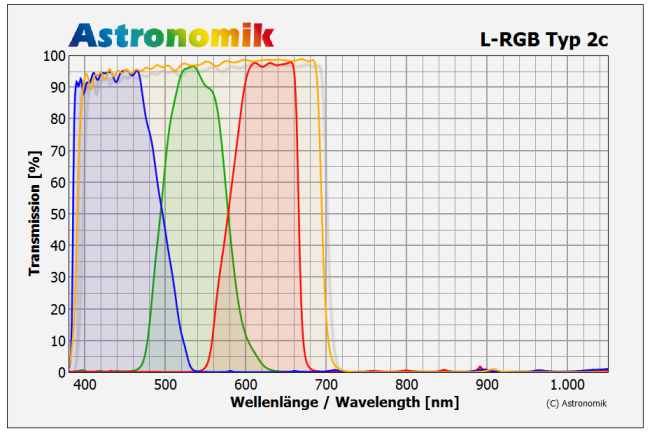About this product
Model: ak_l-rgb_125
Part Number: 10220125
Designed for astrophotography with CCD cameras. These filters provide a natural colour reproduction of planets, stars, emission- and reflection nebulas.
The transmission properties of the L-RGB Typ 2c filters are optimized for CCD astrophotography. The set allows to take images in correct colour for all types of objects. Where other brands make strange compromises, we do the best colour reproduction possible. Both stars as well as objects that emit only in spectral lines, are reproduced in their true colors. You get CCD images with perfect colors, as if the objects where bright enough to be seen with photopic vision. This feature is the main difference between Astronomik filters an those of other manufacturers.
The following aspects have been most important for the design of this filter set:
- Simple image processing for the user
- Highest transmission (nearly 100%) for short exposure times
- Adjusted transmissions of the individual filters for optimal colour reproduction
- The use of industry standards
Astronomik doesn't stop thinking at the step of taking the picture. More important a tool should be given to the astrophotographers that offers a simple and elegant editing process. To maintain the colour, we calculated our filterset for the sRGB color space, that is used as an industry standard from most manufacturers of monitors, printers and imaging software. As a user you do not need to spend time to learn about colourimetry and colour spaces. We have solved the special problems of astrophotography for you.
Due to the high-precision machining of the carrier substrate, Astronomik filters are parfocal with wedge errors below all usual margins. In order not to be the bottleneck in a high-quality optical system Astronomik filters are of course diffraction limited. Issues concerning focal distances as well as the exact location of the images of each colour image are not a problem at all!
FEATURES
- Maximum transmission of nearly 100%
- Optimal colour reproduction
- Optimised spectral windows for max photon counts on the sensor
- Made on the finest, optically polished glass
- Extremly durable, scratch resistant coating
- MFR Coating technique for a wide range of focal ratios
Main Use
The L-RGB filter set divides the spectrum into its components red, green, blue and luminance. Thus colour separation can be achieved with pure b/w CCD sensors. The separation corresponds to the colour sensitivity of the human eye according to DIN 5032. By using the sRGB color space it is possible to maintain the color of the image throughout the entire image processing and output. With an Astronomik L-RGB filter set and your camera you create ideal raw material for imageprocessing in the sRGB color space.
Other uses
- In combination with the Astronomik line filters your images will show interesting details of astronomical objects. For example, the red image can be enhanced by H-alpha or the green image by OIII.
- For planetary observation and photography the colour filters are gladly "misused".
Transmission Chart

- The horizontal axis is the Wavelength in Nanometers (nm). 400nm is deep blue, at 520nm the human eye senses green and at 600nm red. At 656nm is the famous "H-Alpha" emission line of hydrogen.
- The transmission in % is plotted on the vertical axis.
- The most important emission lines from nebulas are shown in orange. The most important lines are from ionised Hydrogen (H-alpha and H-beta) and double ionised oxygen (OIII).
The major emission lines of artificial light pollution:
| Hg 435,8nm | Hg 546,1nm | Hg 577,0nm | Hg 578,1nm |
| Na 589,0nm | Na 589,6nm | Na 615,4nm | Na 616,1nm |
The major emission lines of nebulas:
H-β 486,1nm | OIII 495,9nm | OIII 500,7nm | H-α 656,3nm
Suitability
- Visual observation (dark skies): Good, used as colour filter for planetary observations
- Visual observation (urban skies): Good, used as colour filter for planetary observations
- Film photography: Unsuitable
- CCD photography: Very good, excellent colour separation with RGB and L-RGB pics
- DSLR photography (original): Unsuitable
- DSLR photography (astro modified): Unsuitable
- DSLR photography (MC modified): Unsuitable
- Webcam / Video (Planets): Good, used as colour filter for imaging planets
- Webcam / Video (Deep Sky): Good, used as colour filter for imaging planets
Technical Data
- Not sensitive to humidity or aging
- Scratch-resistant!
- Excellent carrier material. The optical performance of your telescope is not reduced by the filter in any way.
- Parfocal with other Astronomik filters
- Glass thickness: 1mm
- Completely resistant against high humidity, scratches and ageing effects
- Diffraction limited, the filter will not reduce the optical performance of your telescope!
- Astronomik filters are delivered in a high-quality, long lasting, filter box
Customer reviews
FAQ
Please fill in the form below to ask a question.